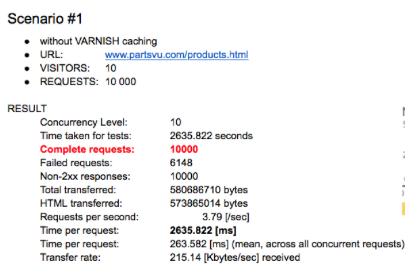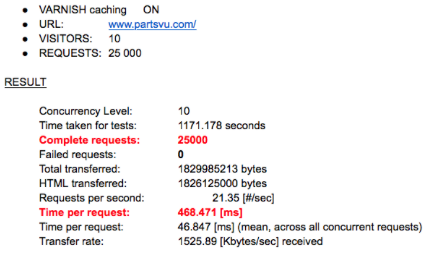
It’s no secret that we live in a world of speed and instant gratification. Nowhere is this more true than in the world of eCommerce, where consumers expect to find exactly what they are looking for right away. However, speed should be just as important to the retailer as it is to the consumer. Why? As shown in the following EYEMAGINE performance test with PartsVu, the speed of a website’s page loads has a direct, effective, measurable impact on both the amount of revenue and the number of visitors that the site generates. Here’s a closer look at why this is and how EYEMAGINE improved speed in this case study.
During this performance test, the EYEMAGINE team used VARNISH caching to increase both the speed of page loads and the success rate of page visits. What is a VARNISH cache? Why does it make such a difference? To answer these questions, we first must explain what usually happens when someone tries to visit a website.
SEE ALSO: New Developments to Consider Before Building on Magento 2.0
The Problem
Normally, when a visitor clicks on a website page, that site visit request is sent directly to the website’s server or back-end—in the case of most EYEMAGINE websites, to the Magento server—where the request is processed and sent back to the visitor, who can then see the page they asked for. However, there are certain issues that can arise when the requests are sent directly to the Magento server in this way. Magento can only handle a limited number of visits at a time, which means that if too many people try to view the website at the same time, the site will crash, load times will increase, etc. In other words, the site just won’t work. For an eCommerce retailer, this is a huge problem—particularly during peak times like the holiday season—since it means loss of leads, conversions, reliability and customers. In our case study we saw this issue firsthand: without VARNISH caching, a whopping 6148 out of 10000 site visit requests failed, and the pages that did load took 2635.822 milliseconds to do so.

The Solution
Including a VARNISH cache solves these problems. The VARNISH cache is essentially an extra line of communication between the visitor and the Magento server: when a visitor clicks on a site page with VARNISH on, the request goes to the cache server first. Then, the cache server and Magento communicate with each other, merge the page and send it back to the visitor. Why is this extra step better? The VARNISH cache server can handle way more visits than Magento with much faster load times. In the same case study, we sent 25,000 site visit requests—over double the original number of requests—with VARNISH cache on. Even with this increase in volume, there were zero failed requests and the time per request was reduced to 468.471 milliseconds.

This improvement is extremely valuable to any eCommerce retailer, since the amount of revenue that any website generates increases drastically as page load speed increases. Speed is, simply put, the one thing that a retailer can improve to immediately increase the profitability of their website, even if every other element stays the same. It’s instant gratification for everyone involved.


